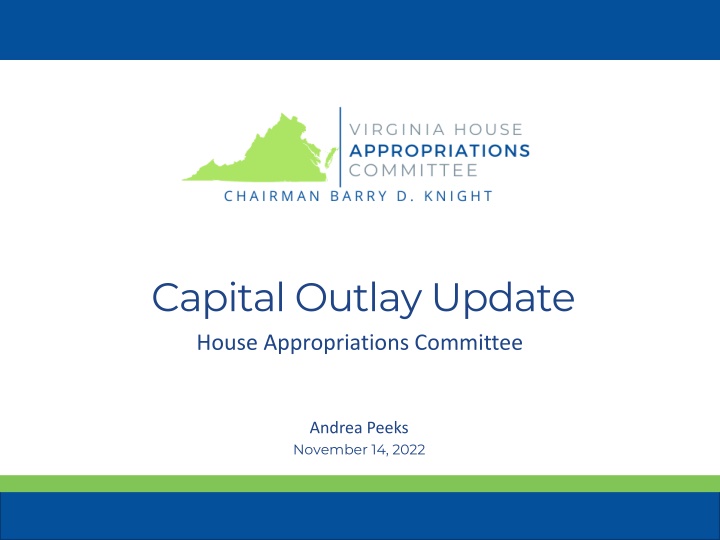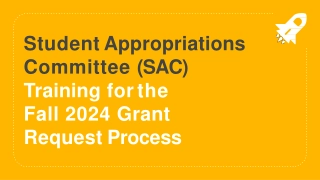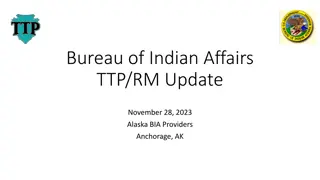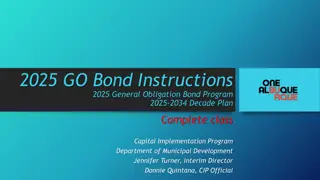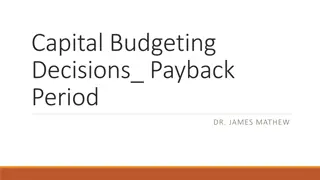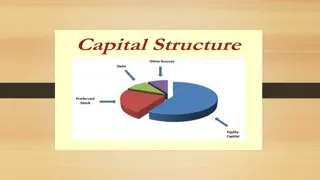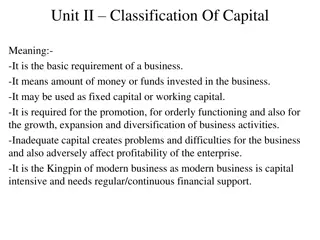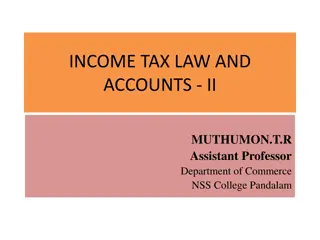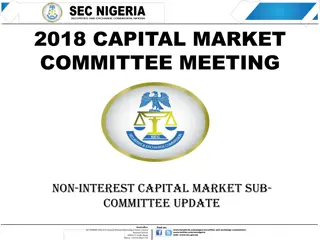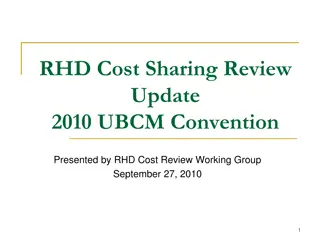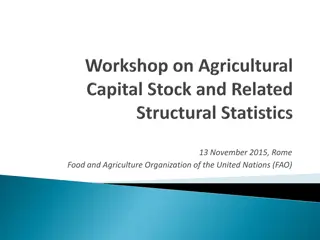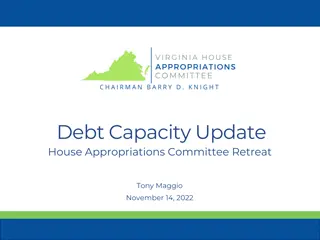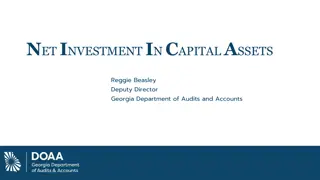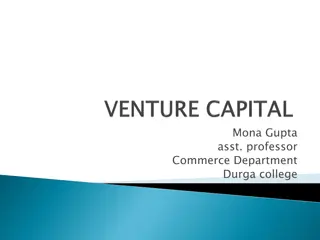Capital Outlay Update for Virginia House Appropriations Committee
This update covers the basics of capital outlay, types of capital, funding methods, recent actions, project cost increases, existing funding commitments, and capital priorities for the 2023 session as presented to the Virginia House Appropriations Committee by Chairman Barry D. Knight.
Uploaded on Mar 03, 2025 | 1 Views
Download Presentation

Please find below an Image/Link to download the presentation.
The content on the website is provided AS IS for your information and personal use only. It may not be sold, licensed, or shared on other websites without obtaining consent from the author.If you encounter any issues during the download, it is possible that the publisher has removed the file from their server.
You are allowed to download the files provided on this website for personal or commercial use, subject to the condition that they are used lawfully. All files are the property of their respective owners.
The content on the website is provided AS IS for your information and personal use only. It may not be sold, licensed, or shared on other websites without obtaining consent from the author.
E N D
Presentation Transcript
Capital Outlay Update House Appropriations Committee Andrea Peeks November 14, 2022 VIRGINIA HOUSE APPROPRIATIONS COMMITTEE Chairman Barry D. Knight
Overview Capital Outlay Basics Types of capital, funding methods, recent actions Project Cost Increases Recent drivers and future implications Existing Funding Commitments Construction, equipment, and supplements Capital Priorities for the 2023 Session VIRGINIA HOUSE APPROPRIATIONS COMMITTEE Chairman Barry D. Knight 2
Capital Outlay Basics Virginia owns over 145 million gross square feet (GSF) of building space 70% is owned by institutions of higher education, of which ~55% is GF- supported, and 30% is owned by state agencies Historic growth of total GSF owned statewide averages 3% annually Primary Space Usage All Agencies 15.0% % of Total Space 10.0% 5.0% 0.0% Total GSF includes state-owned properties tracked in the state s real estate and assets management system, COVA Trax, as of October 2022, plus VDOT & VPA. Does not include data for other entities not required to report in COVA Trax: ABC, DWR, DEQ, Aviation, New College Inst., & VEC. VIRGINIA HOUSE APPROPRIATIONS COMMITTEE Chairman Barry D. Knight 3
Types of Capital Outlay New Construction Acquisition Maintenance Reserve Improvements Dedicated Infrastructure Accounts Renovation Umbrella Projects Equipment VIRGINIA HOUSE APPROPRIATIONS COMMITTEE Chairman Barry D. Knight 4
Capital Outlay Funding Pool Process The pool process was established in 2008 Ideal for GF projects (i.e., those financed with cash and/or GF-supported debt) Allows for operational and procurement efficiencies Pools receive a single, total appropriation equal to the sum of all projects in the pool As projects progress and cost estimates are refined, funding is administratively moved between projects and an overall total is maintained for the pool as a whole Until this year, shortfalls have been addressed via overage transfers from other pools and centrally-allocated supplements VIRGINIA HOUSE APPROPRIATIONS COMMITTEE Chairman Barry D. Knight 5
Pool Process Funding Points Supplements Agency finalizes design; receives authority to proceed to construction, constructs project Project is finalized and any balances remaining revert to the construction pool DGS reviews and provides est. project budget Agency progresses on design; requests construction funding Project Furniture added to a pool Project added to a Planning Pool Project added to a Construction Pool Agency requests a project Project is complete Process simplified to show general progression of a project funded via the pool process VIRGINIA HOUSE APPROPRIATIONS COMMITTEE Chairman Barry D. Knight 6
Capital Outlay Funding Stand Alone Stand-alone projects are set-out individually and not in a pool Projects of all sizes funded entirely with NGF Replacement/repair projects funded fully or partially with GF: Improvement projects: Medium-to-large maintenance reserve (MR)- type project Umbrella projects: A series of similar MR-type projects for one or multiple facilities, or different MR-type projects for one facility Designated infrastructure accounts (ex: DOC Infrastructure Fund, DCR parks deferred maintenance, etc.) Maintenance Reserve: Repair/upkeep projects under $2.0 million ($4.0 million if a roof project); annual allocation provided for all GF-supported facilities Total amount appropriated is allocated to state entities according to a new methodology that considers buildings relative age VIRGINIA HOUSE APPROPRIATIONS COMMITTEE Chairman Barry D. Knight 7
Capital Actions in the 2022 Session In 2022, the General Assembly funded $3.7 billion in capital Advanced over 100 projects without adding tax-supported debt Prioritized projects already in the pipeline, that provide improvements or life/safety compliance, or enhance accessibility Provided $450.0 million to supplement previously-authorized projects 2022 Capital Project Type 2022 Capital Funding Source NGF (cash & debt) $1.2 billion Pool Projects $1.5 billion GF (all cash) $2.5 billion Stand-Alone* $2.2 billion *Of the total $2.2 billion in authorization for stand-alone projects, over $1.0 billion was for projects for the Virginia Port Authority VIRGINIA HOUSE APPROPRIATIONS COMMITTEE Chairman Barry D. Knight 8
Capital Outlay Funding History The state has authorized $27.4 billion in capital since 2002 38% of these projects have been authorized since 2021 2022 GF cash infusion to capital was the largest in state history $4,500 $4,000 Total Capital Authorized $3,500 $3,000 (in millions $) $2,500 $2,000 $1,500 $1,000 $500 $0 NGF or NGF-Supported Debt GF or GF-Supported Debt VIRGINIA HOUSE APPROPRIATIONS COMMITTEE Chairman Barry D. Knight 9
Overview Capital Outlay Basics Types of capital, funding methods, recent actions Project Cost Increases Recent drivers and future implications Existing Funding Commitments Construction, equipment, and supplements Capital Priorities for the 2023 Session VIRGINIA HOUSE APPROPRIATIONS COMMITTEE Chairman Barry D. Knight 10
Project Costs Are Increasing Main factors driving recent cost increases: Market volatility/inflation Global and domestic supply chain challenges State prevailing wage requirements Percentage increase varies by project and depends on: Project size, scope, and complexity Agency capacity Time since the project was authorized for planning or construction Additional project requirements Dependence on outside actors; etc. While economic projections foresee a softening rate of cost inflation due to pandemic supply chain issues, costs may be permanently higher due to continued high rates of inflation VIRGINIA HOUSE APPROPRIATIONS COMMITTEE Chairman Barry D. Knight 11
Calculating Cost Inflation Measurement of annual inflation based on price changes for a standard construction basket of goods Recent annual inflation averaged between 3.0% and 4.5% until 2021 Ongoing impact anticipated as rates compound annually 10-Year Cumulative Impact of Construction Cost Inflation (base of $1.00 cost in 2012) Up 60% from 2020 by the end of 2024 (est.) $2.50 Up 33% from 2020 by the end of 2022 $2.00 $1.50 $1.00 2012 2013 2014 2015 2016 2017 2018 2019 2020 2021 2022 2023, est. 2024, est. VIRGINIA HOUSE APPROPRIATIONS COMMITTEE Chairman Barry D. Knight 12
Overview Capital Outlay Basics Types of capital, funding methods, recent actions Project Cost Increases Recent drivers and future implications Existing Funding Commitments Construction, equipment, and supplements Capital Priorities for the 2023 Session VIRGINIA HOUSE APPROPRIATIONS COMMITTEE Chairman Barry D. Knight 13
Obligation to Fund Previously-Authorized Projects Significant funding may be needed in the near-term to support previously-authorized projects Timing of specific funding need depends on many factors Project timing, size, scope, and complexity Agency capacity and cooperation of outside entities Market and supply chain conditions Agency/institution ability to provide NGF support VIRGINIA HOUSE APPROPRIATIONS COMMITTEE Chairman Barry D. Knight 14
Supplement Funding Supplements Agency finalizes design; receives authority to proceed to construction, constructs project Project balances remaining revert to the construction pool Agency progresses on design; requests construction funding DGS reviews and provides est. project budget Project added to a Construction Pool Project furniture added to a pool Agency completes project Agency requests a project Project added to a Planning Pool ~$5.5 billion in previously-authorized projects may require additional funding Any new supplements would be addition to the $450.0 million provided in 2022 Total additional need depends on project timing, complexity, scope, compounded market conditions at time of construction, and agency ability to reduce scope, provide NGF, and/or value engineer VIRGINIA HOUSE APPROPRIATIONS COMMITTEE Chairman Barry D. Knight 15
Construction Funding Supplements Project balances remaining revert to the construction pool Agency finalizes design; receives authority to proceed to construction, constructs project Project added to a Planning Pool DGS reviews and provides est. project budget Agency progresses on design; requests construction funding Agency completes project Project furniture added to a pool Project added to a Construction Pool Agency requests a project ~$1.4 billion for previously-authorized projects still being planned for which construction funding has not yet been authorized Cost estimate based on latest available project information and includes all funds The state already has committed millions of dollars to design these projects and delays in proceeding to construction may compound costs VIRGINIA HOUSE APPROPRIATIONS COMMITTEE Chairman Barry D. Knight 16
Furniture, Fixtures, and Equipment (FF&E) Supplements Project furniture added to a pool Agency progresses on design; requests construction funding Agency finalizes design; receives authority to proceed to construction, constructs project Project balances remaining revert to the construction pool Project added to a Construction Pool Project added to a Planning Pool Agency completes project Agency requests a project DGS reviews and provides est. project budget Funding for FF&E is not provided until near project completion Total FF&E cost for currently-authorized projects could range from ~$300-$500 million Estimate is for all projects currently authorized Total cost and timing variable and based on overall project progress and composition VIRGINIA HOUSE APPROPRIATIONS COMMITTEE Chairman Barry D. Knight 17
Overview Capital Outlay Basics Types of capital, funding methods, recent actions Project Cost Increases Recent drivers and future implications Existing Funding Commitments Construction, equipment, and supplements Capital Priorities for the 2023 Session VIRGINIA HOUSE APPROPRIATIONS COMMITTEE Chairman Barry D. Knight 18
Top Priorities Fund existing commitments for previously-authorized projects Construction Equipment Supplements Address new critical life/safety and infrastructure needs Increase funding for the maintenance and renovation of existing facilities VIRGINIA HOUSE APPROPRIATIONS COMMITTEE Chairman Barry D. Knight 19
Priority: Existing Commitments Have authorized over $6.8 billion in GF-supported capital since 2019; need to allow time for these projects to progress Of the previously-approved projects in the pipeline: ~$1.4 billion for construction for projects previously-authorized for planning ~$300-$500 million for FF&E for projects previously authorized Additional funds for project supplements as needed Timing uncertainty Depends on a wide variety of factors and likely that only a portion of these obligations will come due in the current biennium, but full bill will come due in near future VIRGINIA HOUSE APPROPRIATIONS COMMITTEE Chairman Barry D. Knight 20
Priority: New Critical Needs Immediate, stand-alone infrastructure repairs Boilers, chillers, water drainage lines and piping, HVAC systems, steam distribution systems, etc. Life/Safety Demolish derelict structures Address ADA compliance issues Replace faulty underground storage tanks Opportunities that promote economic development and/or enhance community health priorities Estimated cost ~$300.0 million VIRGINIA HOUSE APPROPRIATIONS COMMITTEE Chairman Barry D. Knight 21
Priority: Enhance Funding to Maximize Life and Use of Existing Facilities Need to address substantial deferred maintenance backlog Diligent upkeep extends overall facility life and usefulness, maximizes prior investments, and reduces future costs 50-year building standard still requires ongoing maintenance and a significant refresh near the lifespan mid-point Three-fold approach: Smaller-scale/ongoing upkeep needs addressed by an increased maintenance reserve allocation Medium-scale projects addressed as umbrella projects or stand- alone improvements Large-scale renovations, repairs, and/or replacements should be a top priority for future capital pools VIRGINIA HOUSE APPROPRIATIONS COMMITTEE Chairman Barry D. Knight 22
Priority: Adhere to Process The capital outlay process established in 2008 has helped to provide greater control and visibility on cost increases Some minor process adjustments may be needed, but the overall structure remains sound Going forward, continued adherence to process principles is critical for maximum efficiency and effectiveness Require planning prior to authorizing construction Utilize funding pools where feasible Track progress of approved projects to maintain cost visibility Continue ongoing oversight by the Six-Year Capital Outlay Plan Advisory Committee VIRGINIA HOUSE APPROPRIATIONS COMMITTEE Chairman Barry D. Knight 23
QUESTIONS? VIRGINIA HOUSE APPROPRIATIONS COMMITTEE Chairman Barry D. Knight 24
